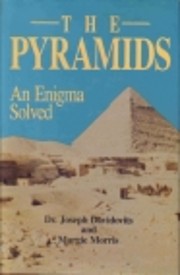

Carregue numa fotografia para ir para os Livros Google.
|
A carregar... The Pyramids: An Enigma Solvedpor Joseph Davidovits
 Nenhum(a) Ainda não há conversas na Discussão sobre este livro. The pyramids made of concrete? This book has three-fourths convinced me. Why? The stones were huge and fit together so perfectly. "But I saw on the history channel that they created similar blocks and built a little mini-pyramid," you say. The main problems with those "recreations" is that they (a) only make itty-bitty blocks, and (b) they use iron tools. The pyramids have blocks of dozens of tons and only had soft copper tools. Try knocking something made of copper up against a rock for a bit and you'll get the point. There is no feasible way to cut thousand upon thousands of blocks. Davidovits makes an excellent case, but, unfortunately, is almost completely ignored by the establishment. sem críticas | adicionar uma crítica
New theories are espoused concerning the construction of the pyramids. Não foram encontradas descrições de bibliotecas. |
Current DiscussionsNenhum(a)Capas populares
 Google Books — A carregar... Google Books — A carregar...GénerosSistema Decimal de Melvil (DDC)690.680932Technology Building BuildingClassificação da Biblioteca do Congresso dos EUA (LCC)AvaliaçãoMédia: (3.38) (3.38)
É você?Torne-se num Autor LibraryThing. |
||||||||||||||||||||||||||||||||||||||||||||||||||||||||||||||||||||||||||||||||||||||||||||||||||||||||||||||||||||||||
In the unlikely event that anybody here is unfamiliar with Egyptcrete, I should give a little background: Davidovits’ theory is that the blocks of the Great Pyramid and other pyramids were cast in place rather than quarried, using some magical alchemical mixture. His physical evidence for this is slight: he claims to have found one block with a “foreign” stone imbedded in it; he provides a poor picture but doesn’t give a location, making it impossible for anyone else to go check. The rest of his evidence is just rhetoric: the Egyptians couldn’t have possibly cut all that stone with copper tools, they couldn’t have moved all those blocks, etc.
Just about every page in the book has errors, distortions, or outright falsehoods. I’ll only give a couple of examples:
* In his chapter on “The False Proofs of Egyptology” [page 62] he discusses the wall paintings from the tomb of the New Kingdom official Rekhmire, which show stone blocks being carved. He casually dismisses this: “This painting was produced 1,300 years after the construction of the Great Pyramid, and, therefore, is not relevant.”
A few pages further on [page 73] he discusses “a bas-relief that may depict a large stone block being cast.” Guess where it’s from? That’s right, the formerly irrelevant tomb of Rekhmire. What’s more, he provides his own (figure 10, page 72) interpretation of the painting which apparently shows an Egyptian standing on the “mold” which is actually a brick wall under construction), pouring liquid (presumably Egyptcrete) into it. Davidovits is either ignorant of the Egyptian style of painting or is being deliberately misleading; because, despite their “advanced technology”, the Egyptians never figured out perspective, they portrayed three-dimensional scenes on a two-dimensional surface by using “registers” and showed events in the background by putting them above the foreground. That’s quite clear from the original Rekhmire painting (and thousands of others); Davidovits has conveniently omitted another worker shown in the original from his “reconstruction” since if the first worker was, in fact, standing on the “block” rather than in a background register, the second worker would be standing in midair.
* In an even more egregious example, Davidovits cheerfully decides to retranslate the “Famine Stela” at Elephantine to support his theories. Again, some background is necessary: this is an inscription from the reign of Ptolemy V (2nd century BC) relating a supposed dream by the 3rd Dynasty Pharaoh Djoser (builder of the Step Pyramid, roughly 2500 years earlier). The intent of the stela is to get Ptolemy to endow the temple of Khnum by associating it with the famous ancient king; Davidovits decides, instead, that it is associated with the manufacture of Egyptcrete. Exactly how Davidovits learned to read Late Egyptian isn’t clear; the book has a reference list, but, strangely enough, all the references are papers or other books by Davidovits. In any event, Davidovits is able to translate a number of words, especially and not surprisingly technical terms for rocks and minerals that have otherwise stumped Egyptologists. Annoyingly, Davidovits’ fanciful “translation” is widely available on the Web. It’s also not clear why a text written 2500 years after the construction of the pyramids is somehow relevant to Egyptcrete, especially after Davidovits himself dismissed much older data.
Davidovits complains throughout that Egyptologists and chemists have not taken his work seriously. I’m not surprised. (